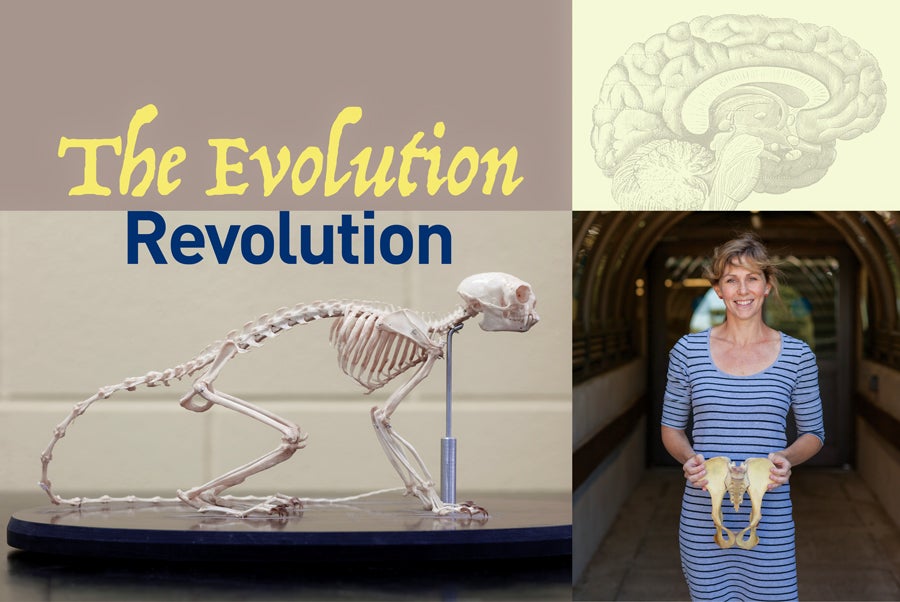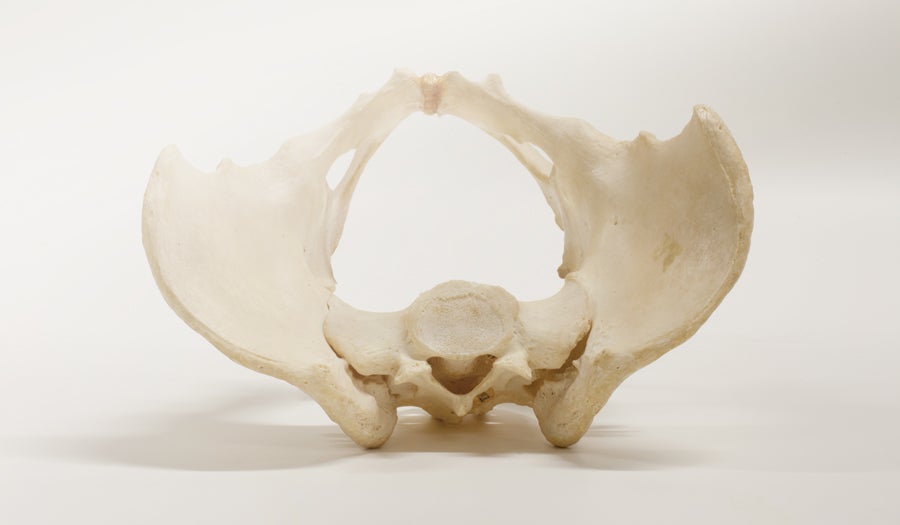Why are we the way we are? Evolution may hold the answers, and they’re not always the ones we expect.
By Todd McLeish
Holly Dunsworth finds herself in the news far more often than most anthropology professors. She has been featured on National Public Radio talking about why babies cry, in The Guardian of London about why childbirth is so difficult, in the Washington Post about why chimps can’t throw well, in Smithsonian magazine about why human pregnancies last nine months, and in dozens of other prominent media outlets around the world, from the BBC to the New York Times.
Reporters call her about a wide range of topics related to human evolution because she is highly quotable, has fascinating insights, and her research often debunks long-held beliefs about how and why primates evolved as they did.
The chair of the URI Department of Sociology and Anthropology, Dunsworth says that despite the controversies surrounding it, human evolution is a very personal subject. She has a great curiosity about where humans came from, in part because it provides insight about where she came from.
“I find so much meaning in learning about our natural history, much like I imagine history enthusiasts feel about history—just deeper in time,” she says. “It’s also exciting because it involves so many different fields of science. It’s a never-ending opportunity to learn about so many fascinating things.”
Dunsworth often asks students in her classes how evolutionary thinking could make a positive impact on culture and society. “They come up with great answers about how knowing where you come from solidifies the idea that we’re all one species and we all share an origin story,” she said. “For many students, it intensifies the need to cooperate and do better.”
Evolution is a complicated topic to understand, however, and because many people first learn about it through pop culture references, they often don’t have an accurate grasp of the subject.
“We’re learning all the time how complicated evolution is,” says Dunsworth. “It’s not something you can just pick up and get a nuanced understanding of, not even in a semester of study. There are a lot of misconceptions. There is a lot of unlearning that has to go on in my classes.”
It’s not just her students who have to unlearn some of what they thought they knew about evolution. Many professional anthropologists have some unlearning to do too, thanks to some of Dunsworth’s research that is shedding new light on topics that many anthropologists thought were resolved long ago.
Take the Obstetric Dilemma, for Instance
Two traits that set humans apart from other primates—big brains and the ability to walk upright—could be at odds when it comes to childbirth. Big brains and the big heads that encase them are hard to push through the human birth canal. Yet a wider pelvis, which would allow for easier passage, might compromise bipedal walking. Scientists have long posited that nature’s solution to this problem, which is known as the obstetric dilemma, was to shorten the duration of gestation so that babies are born before their heads get too big. As a result, human babies are relatively helpless and seemingly underdeveloped in terms of motor and cognitive ability compared to other primates.
“All these fascinating phenomena in human evolution—bipedalism, difficult childbirth, wide female hips, big brains, relatively helpless babies—have traditionally been tied together with the obstetric dilemma,” said Dunsworth. “It’s been taught in anthropology courses for decades. But when I looked for hard evidence that it’s actually true, I struck out.”
Based on her research, there is no evidence that hips wide enough to deliver a more developed baby would be a detriment to walking. Nor is there proof that human pregnancy is shortened compared to other primates. In fact, controlling for the mother’s body size, human gestation is a bit longer than expected compared to other primates, not shorter. And babies are a bit larger than expected, not smaller.
Instead, she believes that metabolism might offer a better explanation for the timing of human birth than the size of the pelvis. Every woman who’s carried a child knows that pregnancy is tiring. Using metabolic data on pregnant women, she found that women give birth just as they are about to cross into a metabolic danger zone.
“Mothers can only gestate for so long until they break through this maximum sustainable metabolic rate,” explained Dunsworth. “During pregnancy, women approach that energetic ceiling and give birth right before they reach it. That suggests there is an energetic limit to human gestation length, and it’s likely this is what’s happening in other pregnant primates, too.”
To find out, she has just launched a new metabolic study of pregnant marmoset monkeys living in a captive colony in Texas.
Why We Live Longer, and Other Puzzles
Dunsworth is working to overturn other misconceptions about primate evolution, as well. For instance, she disagrees with the long-held assumption that primates mature slowly and have long life spans because they must allocate more of their energy resources to the development of their large brains. She has an alternative explanation: primates expend much less energy every day.
Dunsworth was part of a team that calculated the total daily energy expenditure of gorillas, chimpanzees, humans, orangutans, lemurs and other primates. They found that primates in zoos, sanctuaries and in the wild burn 50 percent fewer calories than other mammals of similar size. This dramatically reduced metabolic rate accounts for primates’ slow pace of life.
“Primates must be using energy differently than other mammals do,” she said. “We can’t explain it yet, but the way we process energy is different. Maybe we have a different biological clock that slows down our energy use.”
This research may have implications for understanding the health and longevity of humans. Linking daily energy expenditure to the rate of growth, reproduction and aging may shed light on the processes by which humans develop and age. And unraveling the complex relationship between physical activity and energy expenditure may improve our understanding of metabolic diseases.
Dunsworth’s latest battle to resolve questions of human evolution took her into the controversial field of evolutionary psychology, the study of how evolution shapes human behavior. It’s a discipline that often focuses on the evolutionary differences between the genders as an explanation for certain behaviors. Some scientists, for example, say that male primates evolved to be larger and stronger than females because they must compete for females, and larger body size is advantageous in that competition.
A blog posting on the subject by a well-known scientist pulled Dunsworth into a very public online debate that was later recounted in New York magazine. Because this classic take tends to leave the evolution of females out of the equation, she felt it was important to jump into the fray to raise issues of bias and sexism and to advocate for scientific accuracy.
“I couldn’t stay silent any longer,” she said. “So many people who speak about evolution to the public try to tell it with fun, simple story lines that aren’t necessarily the way it is. And often, if you try to critique them, they claim that you’re anti-science or a liberal ideologue. But they just aren’t admitting—or seeing—how complicated evolution is.”
For instance, she has pointed out on Twitter that rather than differences in male and female body size being due entirely to something men do—male competition over women—things that women do might also be a factor. In particular, she posits that the energy demands of reproduction may mean that women simply stop growing sooner. It’s one theory of many; more research is needed.
One of the big misconceptions that Dunsworth must correct in her classes is that evolution means survival of the fittest, and that it only occurs through natural selection.
“And that’s absolutely not true; it doesn’t make sense,” she said. “But to understand it, you have to understand how change happens. Change is happening every generation, natural selection or not.”
In other words, change happens whether or not it’s advantageous. “Genetic mutation is constant,” she explained. “Most of it is not harmful, which just means that most mutations do not prevent themselves from being passed on. Some mutations cause themselves to be passed on…Chance inheritance of one copy of each gene and part of the genome contributes to genetic drift at the population level, which, depending on the circumstances, can shape evolution to the same end result as natural selection can.”
Science’s Social Media Evolution
Much of the recent debate around gender and evolution took place on Twitter, which Dunsworth has adopted as a useful and valuable means of communicating with colleagues, students and the general public about her research and related issues.
“I’m really comfortable talking in the moment on Twitter,” she said. “I’ve found so many colleagues there, and I’ve learned so much about evolution through what people share there. There are so many issues that cause me to speak up, and I have all these ideas that I can post about.
“Twitter is also where I can find my audience of people who don’t know much about evolution or who think it’s unsavory,” Dunsworth added. “Science has come a long way since Darwin’s day. There’s so much I want to share.”•
 Home
Home Browse
Browse Close
Close Events
Events Maps
Maps Email
Email Brightspace
Brightspace eCampus
eCampus




